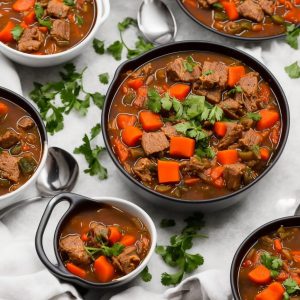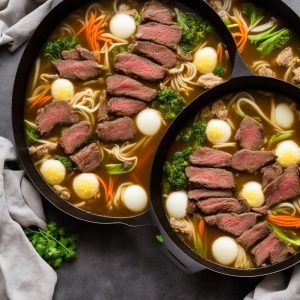Dive into the heart of Mexico with this homely and hearty Mexican Vegetable Beef Soup. Packed with bold flavors from pasilla chiles, cumin, fire-roasted tomatoes, and tender sirloin steak, this soup is a perfect comfort food for any day of the week.
Some ingredients such as the dried pasilla chiles and cumin might not be readily available in your pantry. Pasilla chiles are a type of dried chili pepper from Mexico, known for their unique, mild heat and rich flavor. If you can't find it in your local supermarket, look for them in specialty stores or online. Cumin is a popular spice, used in many cuisines worldwide. It provides a warm, earthy flavor to this soup.
Mexican Vegetable Beef Soup Ingredients
Olive oil: Used as a base for sautéing onions and garlic, providing a flavor foundation.
White onion: Adds a sweet and mild flavor to the soup.
Garlic cloves: Provides a robust, aromatic flavor.
Beef stock: The main liquid base of the soup, infusing it with rich, meaty flavor.
Fire-roasted tomatoes: Enhances the soup with a smoky, charred flavor.
Red peppers: Adds a sweet and slightly spicy flavor.
Carrots: Gives color and added nutrition to the soup.
Yukon gold potatoes: Adds texture and heartiness to the dish.
Sirloin steak: A tender, flavorful cut of beef that adds a meaty substance to the soup.
Dried pasilla chiles: Provides a unique, mild heat to the soup.
Ground cumin: A warm, earthy spice that adds depth of flavor.
Kosher salt: Enhances the flavors of all the ingredients.
Freshly-cracked black pepper: Adds a sharp, pungent flavor element.
Diced avocado: Used as a garnish, it adds creaminess and freshness to the soup.
One reader, Diego Gunn says:





This Mexican vegetable beef soup recipe is a game-changer! The combination of fire-roasted tomatoes, tender sirloin steak, and a perfect blend of spices creates a rich and flavorful soup that's simply irresistible. It's a hearty and comforting dish that's perfect for any occasion. Highly recommend trying it out!
Cooking Techniques for Mexican Vegetable Beef Soup
How to sauté onions and garlic: Sauté the onions in hot oil until softened, then add the garlic and cook until fragrant. This will help to build a flavorful base for the soup.
How to simmer the soup: After adding all the ingredients, bring the soup to a simmer, then reduce the heat and cover. Let it simmer for 20 minutes, or until the potatoes and steak are tender.
How to adjust seasoning: Taste the soup and adjust the seasoning with extra salt, pepper, and cumin if needed. This step ensures the flavors are well-balanced.
How to garnish the soup: Serve the warm soup garnished with diced avocado for a fresh and creamy finish.
How To Make Mexican Vegetable Beef Soup
Serve this warm and filling vegetable beef soup on cold days made with tender steak, fresh veggies, and potatoes with a comforting tomato-chile broth.
Serves:
Ingredients
- 1tbspolive oil
- 1white onionmedium, peeled, and diced
- 4garlic clovespeeled and minced
- 4cupsbeef stock
- 15ozfire-roasted tomatoesdiced
- 12ozred peppersroasted, drained, and chopped
- 2carrotspeeled and chopped
- 1lbYukon gold potatoeschopped
- 2lbsirloin steak cut into 1-inch pieces
- 2dried pasilla chiles or dried guajillo chiles, or 1 to 2 chipotles in adobo sauce, chopped
- 2tspground cumin
- 1tspkosher salt
- ½tspfreshly-cracked black pepper
- diced avocadoor chopped fresh cilantro, diced red onion, and/or crumbled tortilla chips (optional toppings)
Instructions
ON THE STOVETOP:
-
Heat olive oil in a large stockpot over medium-high heat. Add onion and sauté for 5 minutes, stirring occasionally, until softened. Add garlic and sauté for 1 to 2 more minutes until fragrant, stirring occasionally.
-
Add beef stock, tomatoes, red peppers, carrots, potatoes, steak, chiles or chipotles, cumin, salt and pepper, and stir to combine.
-
Continue cooking until the soup reaches a simmer. Then reduce heat to medium-low, cover, and continue simmering for 20 minutes, or until the potatoes and steak are tender.
-
Remove and discard the chiles. Taste and season the soup with extra salt and pepper and cumin, if needed.
-
Serve warm, garnished with your desired toppings.
IN THE INSTANT POT (PRESSURE COOKER):
-
Add all ingredients to the bowl of your Instant Pot, and briefly stir to combine.
-
Close lid securely and set vent to “Sealing”. Press “Manual”, then press “Pressure” until the light on “High Pressure” lights up, then adjust the +/- buttons until the time reads 40 minutes. Cook.
-
Once the soup has cooked, very carefully turn the vent to “Venting” for quick release, and wait until all of the steam has released and the valve has dropped. Remove the lid.
-
Remove and discard the chiles. Taste, and season the soup with extra salt and pepper and cumin, if needed.
-
Serve warm, garnished with your desired toppings.
IN THE INSTANT POT (PRESSURE COOKER):
-
Add all ingredients to the bowl of a large slow cooker, and briefly stir to combine. Cook for 4 hours on high or 8 hours on low.
-
Remove and discard the chiles. Taste, and season the soup with extra salt and pepper and cumin, if needed.
-
Serve warm, garnished with your desired toppings.
Nutrition
- Calories: 362.80kcal
- Fat: 18.73g
- Saturated Fat: 6.88g
- Monounsaturated Fat: 8.32g
- Polyunsaturated Fat: 0.94g
- Carbohydrates: 20.64g
- Fiber: 4.07g
- Sugar: 5.69g
- Protein: 27.72g
- Cholesterol: 88.45mg
- Sodium: 552.28mg
- Calcium: 71.94mg
- Potassium: 1155.18mg
- Iron: 3.40mg
- Vitamin A: 248.10µg
- Vitamin C: 75.43mg
Technique Tip for Enhancing the Flavor of Mexican Vegetable Beef Soup
When preparing your Mexican Vegetable Beef Soup, it's important to remember that the flavors develop over time. To enhance the depth of flavor, consider sautéing the onion and garlic until they are slightly caramelized before adding the other ingredients. This will add a sweet, savory note to your soup. Also, don't rush the simmering process. Allowing the soup to simmer gently will help the flavors to meld together and the beef to become tender. If you're using a pressure cooker or slow cooker, make sure to adjust the cooking time accordingly to ensure that all the ingredients are cooked to perfection.
Time-Saving Tips for Preparing Mexican Vegetable Beef Soup
Prep ahead: Chop vegetables and meat in advance to save time during the cooking process.
Use a pressure cooker: Utilize a pressure cooker to significantly reduce the cooking time for the soup.
Slow cooker convenience: Consider using a slow cooker to allow the soup to simmer and develop flavors while you attend to other tasks.
Batch cooking: Make a large batch of soup and freeze individual portions for quick and easy meals in the future.
One-pot wonder: Opt for a one-pot recipe to minimize the number of dishes and utensils needed for preparation.
Substitute Ingredients For Mexican Vegetable Beef Soup Recipe
olive oil - Substitute with avocado oil: Avocado oil has a similar mild flavor and high smoke point, making it a suitable substitute for olive oil in this recipe.
white onion - Substitute with yellow onion: Yellow onions have a slightly stronger flavor compared to white onions, but they can be used as a substitute in this recipe without significantly altering the taste.
garlic cloves - Substitute with garlic powder: Garlic powder can be used as a substitute for fresh garlic cloves, providing a similar flavor profile while being more convenient.
beef stock - Substitute with vegetable stock: Vegetable stock can be used as a substitute for beef stock to create a vegetarian version of the soup while still providing depth of flavor.
fire-roasted tomatoes - Substitute with canned diced tomatoes: Canned diced tomatoes can be used as a substitute for fire-roasted tomatoes, providing a similar texture and flavor to the soup.
red peppers - Substitute with green bell peppers: Green bell peppers can be used as a substitute for red peppers, adding a slightly different color and flavor to the soup.
carrots - Substitute with parsnips: Parsnips can be used as a substitute for carrots, offering a similar sweet and earthy flavor to the soup.
yukon gold potatoes - Substitute with russet potatoes: Russet potatoes can be used as a substitute for Yukon gold potatoes, providing a similar texture and flavor to the soup.
sirloin steak - Substitute with beef stew meat: Beef stew meat can be used as a substitute for sirloin steak, providing a tender and flavorful alternative for the soup.
dried pasilla chiles - Substitute with dried ancho chiles: Dried ancho chiles can be used as a substitute for pasilla chiles, offering a similar smoky and mild heat to the soup.
ground cumin - Substitute with chili powder: Chili powder can be used as a substitute for ground cumin, adding a different depth of flavor and a hint of spiciness to the soup.
kosher salt - Substitute with sea salt: Sea salt can be used as a substitute for kosher salt, providing a similar level of saltiness to the soup.
freshly-cracked black pepper - Substitute with ground black pepper: Ground black pepper can be used as a substitute for freshly-cracked black pepper, offering a similar flavor and aroma to the soup.
avocado - Substitute with sour cream: Sour cream can be used as a substitute for avocado, adding a creamy and tangy element to the soup.
Presentation Tips for a Delicious Mexican Soup
Elevate the plating: When presenting the Mexican Vegetable Beef Soup, focus on creating an elegant and visually appealing presentation. Use a wide-rimmed bowl to showcase the vibrant colors and textures of the soup. Ensure that the ingredients are evenly distributed and garnish with a drizzle of olive oil and a sprinkle of fresh cilantro for a touch of sophistication.
Incorporate artistic elements: Embrace creativity by incorporating artistic elements into the presentation. Consider using a decorative swirl of sour cream or crema on top of the soup to add a visually striking element. Additionally, you can sprinkle a pinch of smoked paprika in a circular pattern to enhance the overall aesthetic appeal.
Focus on precision: Pay attention to the precision of the plating. Ensure that the soup is ladled carefully into the bowl, and any excess liquid is wiped clean from the edges. Garnish with thinly sliced radishes and jalapeños arranged in a deliberate manner to showcase attention to detail.
Emphasize balance and harmony: Create a sense of balance and harmony on the plate by incorporating complementary colors and textures. Consider adding a small mound of diced avocado in the center of the soup, accompanied by a sprinkle of cotija cheese for a harmonious blend of flavors and visual appeal.
Utilize elegant serving ware: Choose elegant and refined serving ware to elevate the dining experience. Opt for a sophisticated ceramic or porcelain bowl that complements the colors of the soup and enhances the overall presentation. The choice of serving ware can significantly impact the perception of the dish.
Essential Kitchen Tools for Making Vegetable Beef Soup
Large stockpot: A large, heavy-bottomed pot used for making soups, stews, and stocks. It is essential for cooking large batches of soup.
Instant pot (pressure cooker): A versatile kitchen appliance that can be used as a pressure cooker, slow cooker, rice cooker, steamer, and more. It's great for quickly cooking soups and stews.
Large slow cooker: A countertop electrical cooking appliance used for simmering at a lower temperature than other cooking methods, making it perfect for slow-cooking soups and stews.
Food processor: A versatile kitchen appliance used for chopping, slicing, shredding, and pureeing ingredients. It can be helpful for preparing vegetables for the soup.
Mixing bowl: A bowl used for mixing ingredients together. It's essential for combining the various components of the soup recipe.
Chef's knife: A versatile, all-purpose kitchen knife used for chopping, slicing, and dicing ingredients. It's essential for preparing the vegetables and steak for the soup.
Cutting board: A durable board used for cutting and preparing ingredients. It provides a safe and stable surface for chopping vegetables and meat.
Can opener: A tool used for opening cans, including canned tomatoes and other ingredients commonly used in soup recipes.
Measuring cups and spoons: Essential tools for accurately measuring ingredients such as stock, spices, and other seasonings.
Ladle: A long-handled spoon with a deep bowl, used for serving soups and stews. It's essential for portioning the finished soup into bowls.
Tongs: A versatile kitchen tool used for gripping and lifting items, such as turning the steak while cooking or removing the chiles from the soup.
Wooden spoon: A kitchen utensil used for stirring, mixing, and serving. It's essential for stirring the soup while it simmers.
Storage and Freezing Guidelines for Mexican Vegetable Beef Soup
- Let the Mexican vegetable beef soup cool completely to room temperature before storing or freezing.
- Transfer the cooled soup to an airtight container or multiple smaller containers, leaving about an inch of space at the top for expansion during freezing.
- If using a freezer-safe zip-top bag, remove as much air as possible before sealing to prevent freezer burn.
- Label the container or bag with the name of the soup and the date it was made.
- Store the soup in the refrigerator for up to 3-4 days or in the freezer for up to 3 months.
- When ready to enjoy the frozen soup, thaw it overnight in the refrigerator or place the container in a bowl of cold water until it's fully thawed.
- Reheat the thawed soup in a pot on the stovetop over medium heat, stirring occasionally, until it's heated through. Alternatively, you can reheat individual portions in the microwave.
- If the soup appears too thick after thawing and reheating, add a little beef broth or water to achieve the desired consistency.
- Taste the reheated soup and adjust the seasoning with salt, pepper, and cumin if needed.
- Garnish the reheated soup with fresh toppings like diced avocado, cilantro, or a squeeze of lime juice for a bright, fresh flavor.
How To Reheat Leftover Mexican Vegetable Beef Soup
The best way to reheat leftover Mexican vegetable beef soup is on the stovetop. Pour the soup into a pot and heat it over medium heat, stirring occasionally, until it reaches your desired temperature. This method allows you to control the heat and ensure that the vegetables and beef are heated through without becoming overcooked or mushy.
Another option is to reheat the soup in the microwave. Transfer the desired portion of soup into a microwave-safe bowl and cover it with a damp paper towel to prevent splatters. Heat the soup in 30-second intervals, stirring between each interval, until it is heated through. Be careful when removing the bowl from the microwave, as it may be hot.
If you have stored the soup in a freezer-safe container, you can also reheat it from frozen. Transfer the frozen soup to a pot and heat it over low heat, stirring occasionally, until it has thawed and reached your desired temperature. You may need to add a little extra beef stock or water to thin out the soup if it has thickened during the freezing process.
Regardless of the method you choose, be sure to reheat the soup until it is steaming hot throughout to ensure that it is safe to consume. Avoid reheating the soup multiple times, as this can lead to a loss of flavor and texture.
To add a fresh twist to your leftover soup, consider garnishing it with freshly chopped cilantro, a squeeze of lime juice, or a dollop of sour cream before serving. You can also serve the reheated soup with a side of warm tortillas or crusty bread for a satisfying and comforting meal.
Interesting Fact About Mexican Vegetable Beef Soup
The Mexican Vegetable Beef Soup is a hearty and nutritious dish that combines the flavors of fire-roasted tomatoes, sirloin steak, and a variety of vegetables. This soup is a great source of protein, vitamins, and minerals, making it a wholesome meal option for a balanced diet. It's a versatile recipe that can be prepared on the stovetop, in an instant pot, or a slow cooker, offering flexibility for different cooking preferences. Whether you're a fan of traditional stovetop cooking or prefer the convenience of a pressure cooker or slow cooker, this recipe can accommodate various cooking methods. Enjoy the rich and comforting flavors of this Mexican Vegetable Beef Soup on a chilly day!
Is Making Mexican Vegetable Beef Soup at Home Cost-Effective?
The Mexican Vegetable Beef Soup recipe is relatively cost-effective for a household. The combination of beef, vegetables, and spices creates a hearty and satisfying meal. The cost for a household of 4 people is approximately $25, making it an affordable option for a flavorful and nutritious dinner. The versatility of the ingredients also allows for variations based on budget and preference. Overall Verdict: 8.
Is Mexican Vegetable Beef Soup Healthy?
This Mexican vegetable beef soup recipe is a nutritious and well-balanced meal. The recipe includes a variety of vegetables such as onions, garlic, tomatoes, red peppers, carrots, and potatoes, which provide essential vitamins, minerals, and fiber. The lean sirloin steak is an excellent source of protein, iron, and vitamin B12. The use of olive oil, a healthy fat, is another positive aspect of this recipe.
However, there are a few areas where the recipe could be improved to make it even healthier:
- Reduce the amount of red meat and increase the proportion of vegetables to create a more plant-based dish
- Use low-sodium beef stock to control the salt content
- Include more leafy greens, such as spinach or kale, to boost the nutrient profile
- Opt for whole-grain bread or crackers as an accompaniment to increase the fiber content
- Use Greek yogurt instead of sour cream as a topping to reduce saturated fat and increase protein
By making these simple adjustments, you can enhance the nutritional value of this already healthy and delicious Mexican vegetable beef soup recipe. The combination of lean protein, fiber-rich vegetables, and heart-healthy fats makes this dish a nourishing and satisfying meal that can be enjoyed as part of a balanced diet.
Editor's Opinion on This Mexican Soup Recipe
This Mexican vegetable beef soup recipe is a delightful blend of flavors and textures. The combination of fire-roasted tomatoes, red peppers, and sirloin steak creates a rich and hearty base, while the addition of carrots and potatoes adds a comforting element. The use of dried pasilla chiles and ground cumin infuses the soup with a warm and smoky essence, elevating the overall taste profile. Whether prepared on the stovetop, in an Instant Pot, or a slow cooker, this recipe offers versatility and convenience. The finished dish, garnished with diced avocado, is a satisfying and wholesome meal that is sure to impress.
Enhance Your Mexican Vegetable Beef Soup Recipe with These Unique Side Dishes:
Delicious Alternatives to Mexican Vegetable Beef Soup
Appetizers and Desserts That Complement Mexican Vegetable Beef Soup
Why trust this Mexican Vegetable Beef Soup Recipe:
This recipe offers a delightful fusion of flavors and textures, creating a hearty and satisfying Mexican Vegetable Beef Soup. The use of fresh vegetables and high-quality sirloin steak ensures a wholesome and nutritious meal. The inclusion of fire-roasted tomatoes and dried pasilla chiles infuses the soup with an authentic Mexican flair, while the aromatic blend of cumin and garlic adds depth to the dish. With clear instructions for stovetop, Instant Pot, and slow cooker methods, this recipe caters to various cooking preferences, making it a reliable and versatile choice for any home cook.
Was this page helpful?
Have your own special recipe to share? Submit Your Recipe Today!














